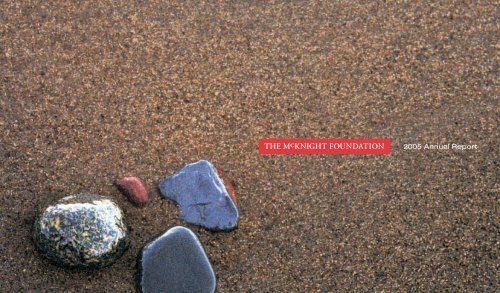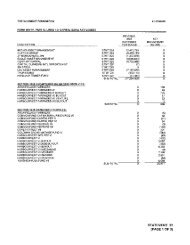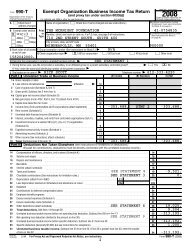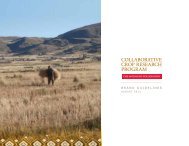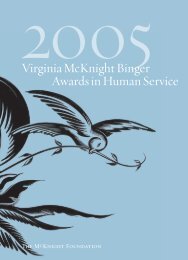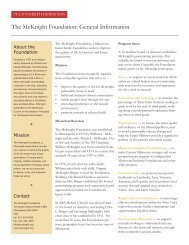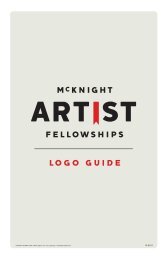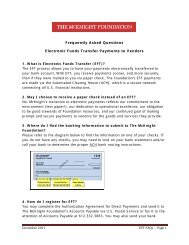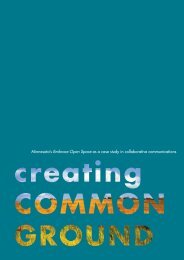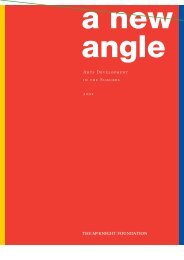PDF, 1 MB - McKnight Foundation
PDF, 1 MB - McKnight Foundation
PDF, 1 MB - McKnight Foundation
Create successful ePaper yourself
Turn your PDF publications into a flip-book with our unique Google optimized e-Paper software.
2005 Annual Report
Now. The instant between heartbeats or ticks of the clock when, we are led to believe, all important decisions<br />
are made and lives change. With so much at stake, it’s easy to get caught up in the present moment — and<br />
imperative to see beyond it. • At The <strong>McKnight</strong> <strong>Foundation</strong>, we like to broaden that critical time frame to<br />
embrace decades and even centuries. The urgency of the moment combines with a longer view, and invites<br />
solutions that can push back standard boundaries for change. • Extending our vision beyond the moment<br />
at hand, we seek the best perspective from which to address a concern. We invest in long-term partnerships<br />
rather than the latest fads. We<br />
REDEFINING<br />
NOW.<br />
explore social issues with an<br />
ever-watchful eye toward future<br />
generations. • Stretching this<br />
window of action requires patience and commitment, of us and of our partners. Positive outcomes and<br />
powerful developments are plenty and constant, but we recognize the greatest successes may not appear<br />
next week. Instead, they take shape slowly over time, as improved lives in a more humane and secure world.<br />
• Now is this moment, but also this year, this generation, this century. Grounded in the present and aiming<br />
past tomorrow, The <strong>McKnight</strong> <strong>Foundation</strong> is working toward long-term progress with our grantees and<br />
partners. Redefining now to encompass lifetimes.
TABLE OF CONTENTS<br />
Letter from the Board Chair 4<br />
Letter from the Interim President 6<br />
Grantmaking Perspectives<br />
Out-of-school time development 8<br />
Twin Cities communities 10<br />
Greater Minnesota economies 12<br />
Renewable energy 14<br />
Annual Highlights 16<br />
Financial Review 19<br />
The <strong>McKnight</strong> <strong>Foundation</strong>, a Minnesota-based private philanthropic organization,<br />
seeks to improve the quality of life for present and future generations. Through<br />
grantmaking, coalition-building, and encouragement of strategic policy reform, we<br />
use our resources to attend, unite, and empower those we serve.<br />
2005<br />
TOTAL # OF GRANTS PAID<br />
816<br />
TOTAL $ OF GRANTS PAID<br />
$90,710,176<br />
LARGEST GRANT PAID<br />
$6,500,000<br />
(Family Housing Fund)<br />
PERCENT OF GRANTS PAID<br />
THAT WERE LESS THAN OR<br />
EQUAL TO $100,000<br />
86%<br />
PERCENT OF GRANTS<br />
PAID THAT REMAINED<br />
IN MINNESOTA<br />
74%<br />
TOTAL ASSETS<br />
$2,050,000,000<br />
(as of 12/31/05)<br />
Board and Staff 20
LETTER FROM THE BOARD CHAIR<br />
In last year’s annual report, I wrote about connections between <strong>McKnight</strong>’s work and<br />
the work of sports teams — groups of people with complementary skills and qualities,<br />
working together to achieve shared goals. This year I would like to take the analogy a<br />
step farther: as much as any squad is the product of all its preparation and practiced<br />
cooperation, team success also depends on an ongoing drive to get the job done<br />
every time the whistle blows.<br />
<strong>McKnight</strong> saw quite a few changes last year. We said goodbye to several<br />
staffers who left indelible imprints on the <strong>Foundation</strong>. We added a new member to our board of directors. Peg Birk<br />
temporarily stepped off the board, after more than three years of service, to become interim president. We are currently<br />
engaged in a national search for the <strong>Foundation</strong>’s next permanent president.<br />
Amid these changes, I believe our greatest strengths remain constant. The <strong>Foundation</strong>’s values, as<br />
Interim President Peg Birk’s annual letter illustrates, bind our work and our spirit together through time.<br />
<strong>McKnight</strong>’s directors, many of whom are descendants of the founders, are deeply committed to our<br />
efforts. Our staff is a model of professional excellence. Our determined<br />
grantees are community powerhouses and experts across many fields.<br />
Our thriving partnerships continue to serve communities in Minnesota and<br />
around the world.<br />
With so much activity on so many fronts, the board recognized<br />
a great opportunity to stand back and take a thoughtful look at exactly how<br />
we, like a sports team, “get the job done” every day. We began a process to<br />
review and restate the <strong>Foundation</strong>’s mission. A successful mission statement<br />
would need to be more than a nice collection of words; we aimed to identify<br />
in simplest terms why our organization exists. Who are we? Why do we<br />
come to work every day? What pushes us to continue, now into our second<br />
half-century?<br />
As you will see, <strong>McKnight</strong>’s mission — strictly speaking, what<br />
we do, and how and why we do it — has not changed. The revised mission<br />
statement simply better reflects our roots and our commitment, and pinpoints<br />
key strategies we use to make a difference:<br />
The <strong>McKnight</strong> <strong>Foundation</strong>, a Minnesota-based private philanthropic<br />
organization, seeks to improve the quality of life for present and future<br />
generations. Through grantmaking, coalition-building, and encouragement<br />
of strategic policy reform, we use our resources to attend, unite,<br />
and empower those we serve.<br />
A couple notes about our final wording. Although <strong>McKnight</strong> has<br />
always been based in Minnesota, this marks our geographic connection’s<br />
first appearance in our mission statement. My great-grandfather, William L.<br />
<strong>McKnight</strong>, lived the majority of his life and established The <strong>McKnight</strong><br />
<strong>Foundation</strong> in Minnesota. We continue to believe strongly in the qualities that<br />
make Minnesota great.<br />
Our ongoing goal is to improve the quality of life for present and<br />
future generations, in all the communities we serve and across many important<br />
program areas. This means we need to look beyond quick fixes for disjointed<br />
issues, and instead pursue interconnections with long-term impacts. That<br />
broader view is crucial, as demonstrated by the grantmaking profiles that follow.<br />
Finally, we serve communities in a variety of ways. Though grants to<br />
nonprofit partners remain our core work, we also consider philanthropic strategies<br />
beyond grantmaking. We believe it essential to use our resources to listen<br />
to our partners and collaborators, bring together those with common goals, and<br />
encourage public policies that support the <strong>Foundation</strong>’s program objectives.<br />
In exploring how to most accurately and appropriately talk about the<br />
<strong>Foundation</strong> and its place in this world, we’ve confirmed an essential truth: The<br />
more things change, the more things stay the same. In many ways, our restated<br />
mission connects as firmly to the <strong>Foundation</strong>’s past as it does to its future.<br />
During transition, paying attention to our central mission helps<br />
our staff and board maintain focus on the most important elements of our<br />
work. The challenges presented by change, like curve balls, are minimized<br />
when you’ve done your work ahead of time. We are trained. We are united.<br />
We have clarity of purpose.<br />
The whistle is blowing, and I look forward to seeing what our next<br />
year together will bring.<br />
Erika L. Binger, Board Chair<br />
4 · The <strong>McKnight</strong> <strong>Foundation</strong> 2005 Annual Report · 5
LETTER FROM THE INTERIM PRESIDENT<br />
As Board Chair Erika L. Binger lays out in her annual letter, 2005 was an important time<br />
for connections at <strong>McKnight</strong>.<br />
Transitions over the past year presented us with a valuable bridge to the<br />
future. Long-term relationships with our partners continue to join us to the communities<br />
we support. Our grantees’ long-range visions unite with our own, in pursuit of common<br />
goals. And, as I explore below, our core values unerringly tie us to the <strong>Foundation</strong>’s<br />
ongoing mission, from the 1950s to the 21st century.<br />
In considering all these important links, the concept of “negative space” has been a useful metaphor.<br />
In visual art composition, negative space is recognized as the space around and between an artwork’s<br />
most obvious subjects. By definition, negative space does not pull focus or distract; rather, it quietly fills the gaps and<br />
connects disparate elements. It’s not what we see the first time we look, and it’s probably not what we remember<br />
longest. But it fills the page.<br />
Perhaps unremarkable at first glance, negative space is nonetheless plotted with purpose. Most artists<br />
believe it merits as much creative attention as their main subject; many<br />
grantmakers might say the same. Because, whether we notice it or not,<br />
what’s between the lines is often what holds the lines together.<br />
A similar invisible glue bonds <strong>McKnight</strong>’s soul with its work, silently<br />
and behind the scenes. We can trace the <strong>Foundation</strong>’s core values back to<br />
our 1953 founding, and they transcend everything we’ve done since, right up<br />
to the present day. As articulated in 2005 by our board of directors, our values<br />
reflect the very heart of who we are and who we strive to be:<br />
Accountability. It is our ultimate responsibility to be good stewards of<br />
our resources, using them wisely to improve the lives of the people and<br />
communities we serve.<br />
Innovation. We recognize the value of innovation, and embrace opportunities<br />
to take educated risks in our grantmaking and partnering.<br />
Integrity. We are honest and forthright. People can trust what we say.<br />
We demand ethical conduct in our actions and expect the same of our<br />
partners. We aim to do the right thing.<br />
Passion. We are committed to our mission and care deeply about the<br />
<strong>Foundation</strong>’s impact on improving the lives of others.<br />
Quality. We define quality not just by our outcomes, but by how the<br />
results are achieved. We strive to follow best practices in all we do.<br />
Respect. We listen to diverse perspectives, trust our partners’ judgment<br />
and counsel, and seek to be fair in relationships with colleagues, partners,<br />
and the communities we serve. These mutually respectful relationships<br />
are a cornerstone of our work.<br />
We don’t expect anyone to memorize our organizational values or<br />
to notice our work “around and between” our primary subjects. Still, all those<br />
quiet connecting pieces ground us and push us forward — from important<br />
restaffing last year, to our search for a permanent president and our ongoing<br />
pursuit of the best strategies to improve lives for generations to come.<br />
As negative space encourages us to look closely between the<br />
lines, the following grantmaking profiles suggest the need for yet another<br />
valuable perspective: a wide-angle lens. For <strong>McKnight</strong>’s work, almost nothing<br />
is more important than aiming a critical eye toward the big picture, across<br />
programs, strategies, geography, and time. In such a panoramic landscape,<br />
our core values become especially welcome, as permanent tethers to the<br />
<strong>Foundation</strong>’s heart and soul.<br />
When the board identifies its next president this year, I will return<br />
to my former seat as a <strong>McKnight</strong> director — yet another connection brought<br />
full circle. In the meantime, my role as interim president continues to reward<br />
me with exciting challenges and invaluable insights.<br />
I have a deepened appreciation for the dedication of the<br />
<strong>Foundation</strong>’s incomparable grantee-partners and outstanding staff, for the<br />
richness of multiple perspectives in any worthwhile effort, and for all the quiet<br />
connections in between.<br />
Peg Birk, Interim President<br />
6 · The <strong>McKnight</strong> <strong>Foundation</strong> 2005 Annual Report · 7
Youth Farm and Market greenhouse (Minneapolis)<br />
We work to improve the lives of Minnesota children and families<br />
through strategic support for early childhood education, youth<br />
out-of-school time programming, homeless and runaway youth,<br />
schools, parent skills building, income support, and financial<br />
savings and management. We support quality programs for<br />
school-age children and youth during the out-of-school time in<br />
the Twin Cities metropolitan area.<br />
Support for out-of-school time programs: $36 million since 1995<br />
At <strong>McKnight</strong>, we see the future in the eyes of a growing child. As they develop, children and young adults need to thrive on several levels — educationally,<br />
socially, and emotionally — for success later in life. In this context, out-of-school time programs and opportunities for year-round learning with topnotch<br />
staff become enormously valuable.<br />
<strong>McKnight</strong> has funded youth programs since the 1970s. But after a fresh look at the field in the mid-1990s, we determined that 5- to 18-<br />
year-olds would be better served if we approached our work more purposefully by focusing on what we believed to be the best qualities of successful<br />
youth programs.<br />
We also learned that professionals and volunteers across the field had a wide range of equally important unmet needs. In Minnesota,<br />
the long-range implications of failing to reach youth through quality out-of-school time programs are plummeting graduation rates, poor relationships<br />
with peers, and diminished developmental expectations. So over the past 10-plus years, we have increased our commitments to afterschool programs,<br />
and broadened support to encompass year-round programming.<br />
We recognize the value of programs that address the changing<br />
needs throughout each child’s development, and that respond to a diversity of<br />
INVEST IN THE FUTURE WHILE IT’S YOUNG.<br />
backgrounds, skills, and interests. We fund youth organizations and activities of<br />
all size and scope — from relatively small innovators like Youth Farm and Market<br />
to resource-rich powerhouses like the YMCA and YWCA. We provide direct<br />
support, and we work through important intermediaries like Youth Community<br />
Connections. Programs relate to tutoring, arts and culture, the environment,<br />
gardening, theater, athletics, and leadership development; many are tailored to meet the specific needs of certain age groups, cultural backgrounds,<br />
and individual interests.<br />
Since the mid-1990s, we have placed a premium on bringing together our out-of-school time grantees to better understand their needs.<br />
Direct contact with program providers allows for long-term field-building and ongoing investments in tomorrow’s youth leaders through promotion of<br />
innovative and exceptional programming.<br />
Over the past decade, as studies have demonstrated the benefits of constructive out-of-school time activities, federal attention and<br />
funding have likewise increased. Dynamic leaders continue to emerge across Minnesota and around the country. And ties continue to strengthen<br />
among youth programs, schools, and informal community resources — all united to support young people.<br />
The children our communities supported in the mid-1990s are now young adults, contributing to their own communities. And the<br />
future, once seen only in their eyes, now lies in their hands.<br />
8 · The <strong>McKnight</strong> <strong>Foundation</strong> 2005 Annual Report · 9
Lake Street and the Midtown Global Market (Minneapolis)<br />
Our Region and Communities program encourages efficient<br />
development within the Twin Cities region to create livable communities<br />
and opportunities for all to thrive. Our strategies include transforming<br />
declining neighborhoods into economically viable communities,<br />
in cooperation with community partners like Twin Cities Local<br />
Initiatives Support Corporation.<br />
Support for Twin Cities Local Initiatives Support Corporation: $10 million since 1991<br />
When you head down your block, do you see people living and working together to create a special place, or just rows of houses and apartments?<br />
We and partners like Twin Cities Local Initiatives Support Corporation see communities working toward healthy development.<br />
Local Initiatives Support Corporation (LISC) was founded in 1980, when access to private development capital for U.S. cities was limited<br />
and public services were sorely lacking. Lower-income communities faced a particularly bleak picture. Today, LISC affiliates in the Twin Cities and<br />
throughout the country provide much-needed financial and technical resources to distressed communities, starting at the neighborhood level.<br />
In partnership with others, Twin Cities LISC focuses resources in several transitional neighborhoods in St. Paul and Minneapolis, neighborhoods<br />
ripe for revitalization. Corporate, government, and philanthropic investments are channeled to help community development corporations<br />
build practical and effective community-based projects.<br />
Beyond core operating support for community development<br />
corporations and other agencies, Twin Cities LISC delivers technical<br />
TOMORROW’S CITIES TODAY.<br />
assistance to spur housing and economic development, training and career<br />
development, capital and financial tools, and valuable information where<br />
they are most needed. LISC fosters community leadership, integrates<br />
transportation investments, revitalizes urban commercial corridors,<br />
promotes policy reform to improve neighborhoods, and — in partnership<br />
with the Family Housing Fund — helps Twin Citians realize the dream of home ownership. Finally, aware that future success in all these areas rests to<br />
some extent on the shoulders of qualified leaders, LISC makes it an explicit priority to train and encourage strong leadership at local levels.<br />
Always looking for what’s on the next block and around the corner, Twin Cities LISC holds vital plans for the future of our communities.<br />
As in many fields, flexibility begets durability. LISC’s best preparation for what’s to come has always been its unfailing ability to adjust to changing<br />
trends and needs, and to recognize those changes by connecting directly to the neighborhoods it serves.<br />
To strengthen neighborhoods, Twin Cities LISC keeps a tight focus on the people inside them.<br />
Twin Cities LISC, www.lisc.org/twin_cities/<br />
10 · The <strong>McKnight</strong> <strong>Foundation</strong> 2005 Annual Report · 11
Northfield, Minnesota<br />
Through the Minnesota Initiative <strong>Foundation</strong>s (MIFs), we provide<br />
resources in Greater Minnesota. Each of the six MIFs tailors<br />
its work to the social and economic needs of its own region<br />
and people. By adapting local support to each of their own<br />
communities, the foundations foster growth and vitality in their<br />
regions while bolstering the economic health of our entire state.<br />
Support for the Minnesota Initiative <strong>Foundation</strong>s: $219 million since 1986<br />
The outlook was grim in Greater Minnesota in the mid-1980s. Entire economic markets grinded to a halt as demand for regional products from<br />
farming, mining, and lumber mills faltered. Families dependent on these industries struggled to make ends meet, while their communities and<br />
infrastructure were rapidly dissolving. Around the state, rural life was coming apart at the seams.<br />
State-sized financial crises can’t be solved in the blink of an eye. Instead we adopted a longer view and a few fundamental convictions:<br />
The vitality of every farm, business, and town is wed to the vitality of the larger community or region that surrounds it. Minnesota’s small towns and<br />
rural areas possess the human energy and commitment to meet their own most critical needs. And decisions to solve local problems are best<br />
made locally, by those with the most at stake.<br />
After sizing up the situation and surveying stakeholders statewide — from community leaders to elected officials and business<br />
owners — <strong>McKnight</strong> created the Minnesota Initiative <strong>Foundation</strong>s (MIFs).<br />
Each of the six MIFs is based in and tailored to a different geographic region. Each has its own board of directors, programmatic<br />
strategies, and independent decision-making process. Through these six<br />
foundations, the responsibility and the resources for regional action are<br />
STRETCHING POSSIBILITIES.<br />
placed firmly in the hands of the people best suited to drive them. Local<br />
individuals and families receive the benefits, enabling them to build healthier<br />
economies that protect their communities against economic slowdowns.<br />
With eyes focused on the enduring success of the state<br />
and its diverse communities, each MIF has spun over two decades of<br />
<strong>McKnight</strong>’s investments — around $200 million since 1986 — into a web of support for the needs of its own region, including innovative programs in<br />
human services, employment, business and leadership development, and community capacity-building. The MIFs work with banks, investors, and<br />
public financing to make grants and loans to businesses. Each has created a separate but parallel business development and loan program to fund<br />
healthy growth at the local level and ensure a strong economic base.<br />
In recent years the MIFs have looked for new ways to partner, in pursuit of statewide kindergarten preparation, rural communities<br />
free of the plague of methamphetamine, and statewide regional economic development. Thanks in large part to the MIFs, working together and<br />
independently, nowadays things in Greater Minnesota are looking up.<br />
Initiative <strong>Foundation</strong>, www.ifound.org; Northland <strong>Foundation</strong>, www.northlandfdn.org; Northwest Minnesota <strong>Foundation</strong>, www.nwmf.org; Southern Minnesota Initiative<br />
<strong>Foundation</strong>, www.smifoundation.org; Southwest Minnesota <strong>Foundation</strong>, www.swmnfoundation.org; West Central Initiative, www.wcif.org<br />
12 · The <strong>McKnight</strong> <strong>Foundation</strong> 2005 Annual Report · 13
Midwestern prairie grasses<br />
In partnership with the San Francisco-based Energy <strong>Foundation</strong>,<br />
we work to ensure the Upper Midwest provides a significant<br />
portion of the nation’s future energy supply from renewable<br />
sources. Our strategies include efforts to generate electricity<br />
through wind; and derive transportation fuel from<br />
prairie grasses, trees, and corn stalks.<br />
Support for the Energy <strong>Foundation</strong>: $33 million since 1998<br />
In stark contrast to the hazy skies over our cities, America’s energy problems are clear as day. Global warming, brought about by our reckless use<br />
of fossil fuels, is causing polar and alpine glaciers to melt. Even as the sea level rises, so does our dependence on foreign energy sources. And any<br />
energy solutions we pursue will affect the quality and sustainability of our environment, for better or worse; the survival of thousands of plant and<br />
animal species is at risk.<br />
It’s a daunting scenario, no question. But the challenges of our current situation also present equally critical opportunities. Our nation<br />
possesses tremendous renewable energy resources. Converting wind and biomass into valuable commodities like electricity and motor fuels has<br />
the potential to catalyze a new economy for farmers and cultivate new wealth in rural America.<br />
In 1996, The <strong>McKnight</strong> <strong>Foundation</strong> began an ongoing partnership with the San Francisco-based Energy <strong>Foundation</strong> to support<br />
alternative energy development in the Upper Midwest. Beyond exploring new ways to power everything in our lives, from lightbulbs to light rail, we<br />
believe it imperative to look for options that tap the renewable resources of the region and benefit local economies.<br />
Looking at things from a national and global perspective,<br />
the Energy <strong>Foundation</strong> is without peer in the advancement of alternative<br />
GENERATING A CLEARER FUTURE.<br />
energy. Supported by a partnership of major donors, the Energy <strong>Foundation</strong><br />
concentrates resources primarily on policy work and research that<br />
encourage renewable energy development. In addition to policy work, the<br />
Energy <strong>Foundation</strong> provides direct support to a variety of other important<br />
organizations, including Minnesotans for an Energy Efficient Economy, the<br />
Institute for Agriculture and Trade Policy, and Wind on the Wires.<br />
In 2005, we broadened our funding to incorporate initiatives to slow the pace of global warming. Over the last decade, our investments<br />
in wind power have helped launch a thriving industry; today, our new venture into biofuels again seeks to spur a nascent enterprise. Different from<br />
corn ethanol, cellulosic biofuels make use of a wide variety of vegetation, such as trees and grasses that require less intensive farming practices<br />
than traditional crops.<br />
Even with painfully obvious problems, the most effective solutions can be hard to spot. To address a global problem with far-reaching<br />
implications for energy supplies and environmental sustainability, the Energy <strong>Foundation</strong> makes use of an equally far-reaching vision. Like the air<br />
and water they work to protect, that vision gets clearer every day.<br />
The Energy <strong>Foundation</strong>, www.ef.org<br />
14 · The <strong>McKnight</strong> <strong>Foundation</strong> 2005 Annual Report · 15
2005<br />
HIGHLIGHTS<br />
AFFORDABLE HOUSING<br />
ARTS BEYOND THE CITY LIMITS<br />
DEPARTURES<br />
EARLY CHILDHOOD DEVELOPMENT<br />
INTERIM PRESIDENT<br />
McKNIGHT DISTINGUISHED<br />
ARTIST<br />
NEW BOARD ME<strong>MB</strong>ER<br />
RENEWABLE ENERGY<br />
VIRGINIA McKNIGHT BINGER<br />
AWARDS IN HUMAN SERVICE<br />
To address ongoing affordable<br />
The <strong>Foundation</strong> published two<br />
Nancy Latimer, a passionate<br />
Three far-reaching grants<br />
Peg Birk was named interim<br />
Rochester sculptor Judy<br />
Richard D. McFarland was<br />
<strong>McKnight</strong>’s board approved<br />
The <strong>Foundation</strong>’s board<br />
housing needs, <strong>McKnight</strong><br />
reports about communities<br />
advocate for early childhood<br />
totaling nearly $6 million<br />
president, following Rip<br />
Onofrio received the 2005<br />
appointed to <strong>McKnight</strong>’s<br />
$20 million over four years<br />
approved 10 Virginia<br />
committed nearly $20 million<br />
outside the Twin Cites thriving<br />
issues and recipient of the<br />
support successful early<br />
Rapson’s departure. Rapson<br />
<strong>McKnight</strong> Distinguished Artist<br />
board of directors. McFarland<br />
to the San Francisco-based<br />
<strong>McKnight</strong> Binger Awards<br />
to two of Minnesota’s leading<br />
because of the arts. You are<br />
Council on <strong>Foundation</strong>s’ 2005<br />
childhood development<br />
provided leadership as presi-<br />
Award. Onofrio’s exuberant<br />
is the former president and<br />
Energy <strong>Foundation</strong>, represent-<br />
in Human Service to<br />
affordable housing support<br />
Here: Exploring Art in the<br />
Robert W. Scrivner Award for<br />
throughout Minnesota. Funds<br />
dent for six years, particularly<br />
work garnered her an interna-<br />
CEO of Dain Rauscher<br />
ing the largest investment to<br />
Minnesotans who have<br />
organizations. St. Paul-based<br />
Suburbs provides a dozen<br />
Creative Grantmaking, retired<br />
support the Minnesota Early<br />
in developing and convening<br />
tional following and helped<br />
Corporation. McFarland’s<br />
date in the foundations’<br />
distinguished themselves by<br />
Greater Minnesota Housing<br />
snapshots of exemplary<br />
as senior program officer<br />
Childhood Initiative’s work to<br />
partnerships around shared<br />
establish southeastern<br />
philanthropic ties date back<br />
13-year partnership. The new<br />
demonstrating a selfless<br />
Fund provides funding and<br />
suburban cultural develop-<br />
after more than two decades<br />
improve early care and<br />
opportunities. Birk, a former<br />
Minnesota’s now-thriving<br />
30 years, to his work with<br />
grant will support the Upper<br />
devotion of time and energy<br />
technical assistance in<br />
ment. Bright Stars: Charting<br />
at <strong>McKnight</strong>. Carol Berde,<br />
education through local<br />
senior vice president of<br />
artist community — she was<br />
Dain Rauscher’s Dain<br />
Midwest Clean Energy<br />
to serving people in their com-<br />
Greater Minnesota to develop<br />
the Impact of the Arts in<br />
who worked at <strong>McKnight</strong> for<br />
projects in Greater Minnesota,<br />
Federated Insurance<br />
instrumental in the creation of<br />
<strong>Foundation</strong>. He also served<br />
Initiative, which encourages<br />
munities. A small committee<br />
affordable housing, and the<br />
Rural Minnesota portrays<br />
a full quarter-century and<br />
and the efforts of Ready 4 K’s<br />
Companies in Owatonna,<br />
both the Rochester Art Center<br />
for 10 years on the board of<br />
wind power development and<br />
of representatives from<br />
Family Housing Fund in<br />
the symbiotic relationship<br />
was a key architect of the<br />
network of informed citizens<br />
Minnesota, has served on<br />
and the Minnesota Crafts<br />
the Bush <strong>Foundation</strong>, St. Paul,<br />
will foster the development of<br />
Minnesota’s human services<br />
Minneapolis preserves and<br />
among vibrant arts, strong<br />
<strong>Foundation</strong>’s award-winning<br />
to influence public policy to<br />
<strong>McKnight</strong>’s board of directors<br />
Council. The <strong>McKnight</strong> award<br />
throughout the 1990s; and<br />
transportation fuel from crops<br />
field meets each year to<br />
produces affordable housing<br />
economies, and community<br />
work in welfare reform, left<br />
improve development sys-<br />
since 2001; she will return to<br />
is given annually to an artist<br />
subsequently became a<br />
such as prairie grasses and<br />
review nominations and make<br />
for families with low and<br />
development in Greater<br />
work as the <strong>Foundation</strong>’s<br />
tems. The third major grant<br />
board service after her tenure<br />
whose long career has<br />
trustee at the Minneapolis<br />
corn stalks.<br />
award recommendations.<br />
moderate incomes in the<br />
Minnesota.<br />
executive vice president<br />
supports the Minnesota Early<br />
as interim president comes to<br />
made a significant impact<br />
<strong>Foundation</strong>.<br />
seven-county Twin Cities<br />
to pursue a career as a<br />
Learning <strong>Foundation</strong>’s initial<br />
an end and a new permanent<br />
in Minnesota and beyond.<br />
region.<br />
nonprofit consultant. Both<br />
work to identify cost-effective<br />
president is hired.<br />
<strong>McKnight</strong> also honored<br />
remain connected to the work<br />
ways to deliver quality early<br />
45 Minnesota artists through<br />
and spirit of the <strong>Foundation</strong>.<br />
care that prepares all children<br />
its artist fellowships program<br />
for kindergarten.<br />
in 2005.<br />
16 · The <strong>McKnight</strong> <strong>Foundation</strong> 2005 Annual Report · 17
GRANTS PAID BY PROGRAM AREA<br />
GRANTS PAID BY GEOGRAPHIC AREA<br />
FINANCIAL REVIEW<br />
····················International 3%<br />
··················Other 7%<br />
·················Research 8%<br />
STATEMENTS OF FINANCIAL POSITION<br />
December 31, 2005 and 2004 (in thousands)<br />
STATEMENTS OF ACTIVITIES<br />
December 31, 2005 and 2004 (in thousands)<br />
················Arts 10%<br />
· · · · · · · · · · · · · · · · MN Initiative <strong>Foundation</strong>s 10%<br />
·····················International 7%<br />
· · · · · · · · · · · · · · · Greater Minnesota 18%<br />
ASSETS<br />
2005 2004<br />
INVESTMENT INCOME<br />
2005 2004<br />
············Environment 15%<br />
· · · · · · · Children & Families 22%<br />
···············National 19%<br />
···············Statewide 19%<br />
Cash $ 65 $ 86<br />
Investments 2,041,431 2,065,523<br />
Interest and Dividends Receivable 6,491 5,231<br />
Interest and Dividends $ 46,813 $ 39,488<br />
Net Realized and Unrealized Gain (Loss) 89,560 167,110<br />
Other (2,250) (1,251)<br />
· · · · · · Region & Communities 25%<br />
········Twin Cities Area 37%<br />
Other Assets 2,608 2,914<br />
Total Assets 2,050,595 2,073,754<br />
Net Investment Income 134,123 205,347<br />
EXPENSES<br />
LIABILITIES AND NET ASSETS<br />
Grants Appropriated, Net of returns $ 109,217 $ 62,667<br />
Grants Payable $ 104,710 $ 86,203<br />
Investment Management 5,523 5,394<br />
Federal Excise and Miscellaneous Taxes 4,882 6,078<br />
Administrative and Program Expense 7,729 7,777<br />
ARTS<br />
Improve the quality of<br />
the arts in Minnesota<br />
and improve access to<br />
the arts for all<br />
Minnesotans.<br />
McKNIGHT SUPPORTS STRATEGIC WORK TOWARD SEVEN CORE PROGRAM GOALS:<br />
CHILDREN AND<br />
FAMILIES<br />
Provide children and<br />
families with the skills,<br />
knowledge, and<br />
resources necessary<br />
for children to thrive<br />
and transition successfully<br />
to adulthood.<br />
ENVIRONMENT<br />
Maintain and restore a<br />
healthy environment in<br />
the Mississippi River<br />
Basin, and promote<br />
renewable energy in<br />
Minnesota and the<br />
Midwest.<br />
INTERNATIONAL<br />
Empower people who<br />
have few opportunities<br />
for social and economic<br />
growth in three countries<br />
each in Africa<br />
(Tanzania, Uganda,<br />
and Zimbabwe) and<br />
Southeast Asia<br />
(Cambodia, Laos,<br />
and Vietnam).<br />
MINNESOTA INITIATIVE<br />
FOUNDATIONS<br />
Strengthen Greater<br />
Minnesota’s communities<br />
and economies<br />
through six independent,<br />
regionally based<br />
foundations.<br />
REGION AND<br />
COMMUNITIES<br />
Encourage efficient<br />
development within the<br />
Twin Cities region that<br />
creates livable communities<br />
and opportunities<br />
for all to thrive.<br />
RESEARCH<br />
Facilitate innovative<br />
neuroscience research<br />
into brain diseases,<br />
and help collaborative<br />
crop research scientists<br />
increase nutritional<br />
security in developing<br />
countries.<br />
Other Liabilities 9,909 59,485<br />
Total Liabilities 119,501 151,766<br />
Unrestricted Net Assets 1,931,094 1,921,988<br />
Total Liabilities and Net Assets 2,050,595 2,073,754<br />
Federal Excise Tax 2,045 3,059<br />
Miscellaneous Tax 503 471<br />
Total Expenses 125,017 79,368<br />
CHANGE IN UNRESTRICTED NET ASSETS 9,106 125,979<br />
UNRESTRICTED NET ASSETS AT<br />
BEGINNING OF YEAR 1,921,988 1,796,009<br />
UNRESTRICTED NET ASSETS AT<br />
END OF YEAR $ 1,931,094 $ 1,921,988<br />
For information about specific program focuses and funding opportunities, visit www.mcknight.org.<br />
18 · The <strong>McKnight</strong> <strong>Foundation</strong> 2005 Annual Report · 19
DIRECTORS<br />
OFFICERS<br />
STAFF<br />
Benjamen M. Binger<br />
Erika L. Binger<br />
James M. Binger<br />
Patricia S. Binger<br />
Cynthia Binger Boynton<br />
Meghan Binger Brown<br />
Zeke Brown<br />
Richard D. McFarland<br />
Ted Staryk<br />
Erika L. Binger<br />
Board Chair<br />
Peg Birk<br />
Interim President<br />
James M. Binger<br />
Treasurer<br />
Patricia S. Binger<br />
Assistant Secretary<br />
Benjamen M. Binger<br />
Assistant Treasurer<br />
Rick Scott<br />
Vice President of Finance<br />
and Compliance, and<br />
Secretary<br />
Susan Baker<br />
Accounting Assistant<br />
Jeannine Balfour<br />
Program Officer<br />
Daniel M. Bartholomay<br />
Program Director<br />
Peg Birk<br />
Interim President<br />
Gretchen Bonfert<br />
Program Director<br />
Erin Christman<br />
Program/Communications<br />
Assistant<br />
Neal I. Cuthbert<br />
Program Director, Interim Vice<br />
President of Program<br />
Stephanie Duffy<br />
Grants Administration Manager<br />
Christine Ganzlin<br />
Program Director<br />
Jamie Hagerty<br />
Accountant<br />
Tim Hanrahan<br />
Communications Director<br />
Sarah Hernandez<br />
Program Officer<br />
Louis Hohlfeld<br />
Senior Program Officer<br />
David Kennedy-Logan<br />
Communications Production<br />
Manager<br />
Shawn Kinniry<br />
Operations Manager<br />
Kathryn Koenigsmark<br />
Executive Assistant<br />
Ron Kroese<br />
Program Officer<br />
Brenda Krotzer<br />
Grants Administration Associate<br />
Cosandra Lloyd<br />
Program Associate<br />
Sarah Lovan<br />
Program Assistant<br />
Mariam Mohamed<br />
Program Officer<br />
Kevin Overson<br />
Program Assistant<br />
Kathleen Rysted<br />
Director of Information<br />
Technology and Research<br />
Programs<br />
Karyn Sciortino<br />
Program Associate<br />
Rick Scott<br />
Vice President of Finance<br />
and Compliance<br />
Therese Simmons<br />
Controller<br />
Janine Steffens<br />
Receptionist/Administrative<br />
Assistant<br />
Alla Vaynberg<br />
Accountant<br />
Laura Zimmermann<br />
Program Officer<br />
The <strong>McKnight</strong> <strong>Foundation</strong> is committed to the protection of our environment, a philosophy that underlies our<br />
practice of using paper with post-consumer waste content, and wherever possible, environment-friendly inks.<br />
Additionally, we partner with printers who participate in the PIM Great Printer Environmental Initiative. This<br />
annual report was printed on Mohawk Options paper, containing 30 percent post-consumer waste.<br />
CREDITS<br />
Tim Hanrahan, communications director<br />
ThinkDesign Group, concept and design<br />
Stan Fellows, illustration<br />
Chris Faust, photography (cover, pages 8, 10)<br />
Darren Olson, photography (inside front cover)<br />
Metropolitan Design Center Image Bank (page 12)<br />
© Regents of the University of Minnesota. All rights reserved. Used with permission.<br />
Diversified Graphics, printing<br />
MATCHING GIFTS<br />
The Employee Matching Gift Program, initiated in June 1996, encourages employee philanthropy and volunteerism. Under<br />
the program, The <strong>McKnight</strong> <strong>Foundation</strong> will match employee gifts up to $2,000 annually per employee on a two-for-one<br />
basis. The <strong>Foundation</strong> will also match each 40 hours volunteered by an employee at a qualifying organization with a $500<br />
gift to the organization. During 2005, 23 employees donated time or money to 84 organizations, which resulted in The<br />
<strong>McKnight</strong> <strong>Foundation</strong> contributing $42,388 to those organizations.
THE McKNIGHT FOUNDATION<br />
710 South Second Street, Suite 400<br />
Minneapolis, Minnesota 55401<br />
t 612.333.4220 f 612.332.3833<br />
www.mcknight.org


